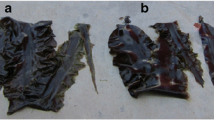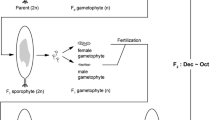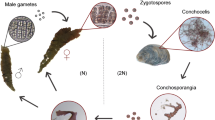Abstract
The kelp Undariopsis peterseniana is warm-water-tolerant, and consequently, there is currently considerable interest in developing commercial cultivation techniques for this species in Korea. U. peterseniana plants have been successfully transferred to the northern coast of Korea beyond their original habitat in Jeju Island (33°30′08.65″N, 126°55′39.02″E). In this study, we cultured a hybrid kelp consisting of a cross between free-living gametophytes of U. peterseniana and U. pinnatifida in an attempt to extend the culture period of Undaria which is an important species for both the abalone industry and for commercial seaweed mariculture for human food applications. Morphological characters and cultivation period were compared between the parent thalli and the hybrid. The cultivation experiment was conducted in Wando, on the southern coast of Korea (34°26′18.68″N, 127°05′43.88″E). The morphological characteristics of the hybrid thalli were intermediate between the two species having shallow pinnated blades and a reduced reproductive organ. Hybrid thalli showed faster growth rates, 1.5 times greater biomass, and a longer cultivation period than the parent thalli. The hybrid strain possessed characteristics that indicate it could be used as an alternative kelp source to supply the abalone feed industry.





Similar content being viewed by others
References
Banga SS (1998) Heterosis: an introduction. In: Banga SS, Banga SK (eds) Hybrid cultivar development. Springer, Berlin, pp 1–16
Belea A (1992) Interspecific and intergeneric crosses in cultivated plants. Akadémiai Kiadó, Budapest
Corazani D, Illanes JE (1998) Growth of juvenile abalone, H. discus hannai Ino 1953 and Haliotis rufescens Swainson 1822, fed with different diets. J Shellfish Res 17:663–666
Druehl LD, Collins JD, Lane CE, Saunders GW (2005) An evaluation of methods used to assess intergeneric hybridization in kelp using Pacific Laminariales (Phaeophyceae). J Phycol 41:250–262
Edding ME, Tala FB (2003) Development of techniques for the cultivation of Lessonia trabeculata Villouta et Santelices (Phaeophyceae: Laminariales) in Chile. Aquacult Res 34:507–515
FAO (2008) Yearbooks of fishery statistics summary tables. ftp://www.fao.org/fishery/publications/yearbooks/en down load 13 June 2011
Hara M, Akiyama K (1985) Heterosis in growth of Undaria pinnatifida (Harvey) Suringar. Bull Tohoku Reg Fish Res Lab 47:47–50
Hwang EK, Baek JM, Park CS (2009) The mass cultivation of Ecklonia stolonifera Okamura as a summer feed for the abalone industry in Korea. J Appl Phycol 21:585–590
Hwang EK, Gong YG, Park CS (2010) Ecological character of the endangered brown alga, Undariopsis peterseniana (Kjellman) Miyabe et Okamura, in Jeju, Korea: growth and maturation. Korean J Fish Aquatic Sci 43:63–68
Hwang EK, Gong YG, Park CS (2011a) Cultivation of a brown alga, Undariopsis peterseniana (Kjellman) Miyabe et Okamura as a warm temperature species by artificial seed production in Korea. J Appl Phycol 23:449–455
Hwang EK, Shim CH, Ha DS, Gong YG, Park CS (2011b) Regeneration and maturation induction of free-living gametophytes of Undariopsis peterseniana for their mass production. Korean J Fish Aquat Sci 44:155–161
Information Officer (2009) Statistical yearbook of maritime affairs and fisheries, Ministry of Maritime of Food, Agriculture, Forestry & Fisheries. http://fs.fips.go.kr/main.jsp downloaded 13 June 2011
Kamiya M, West JA, King RJ, Zuccarello GC, Tanaka J, Hara Y (1998) Evolutionary divergence in the red algae Caloglossa leprieurii and C. apomeiotica. J Phycol 34:361–370
Kapraun DF (1999) Red algae polysaccharide industry: economics and research status at the turn of the century. Hydrobiologia 398/399:7–14
Kirihara S, Nakamura T, Kon N, Fujita D, Notoya M (2006) Recent fluctuations in distribution and biomass of cold and warm temperature species of Laminarialean algae at Cape Ohma, northern Honshu, Japan. J Appl Phycol 18:521–527
Kraan S, Guiry MD (1998) Strain selection in the edible brown seaweed Alaria esculenta: genetic fingerprinting and hybridization studies under laboratory conditions. Mar Res Ser 8:1–30
Lewis JL (1996) Chromosomes of the brown algae. Phycologia 35:19–40
Lewis RJ, Neushul M (1995) Intergeneric hybridization among five genera of the family Lessoniaceae (Phaeophyceae) and evidence for polyploidy in a fertile Pelagophycus × Macrocystis hybrid. J Phycol 31:1012–1017
Li X, Cong Y, Yang G, Shi Y, Qu S, Li Z, Wang G, Zhang Z, Luo S, Dai H, Zie J, Jiang G, Liu J, Wang T (2007) Trait evaluation and trial cultivation of Dongfang no. 2, the hybrid of a male gametophyte clone of Laminaria longissima (Laminariales, Phaeophyta) and a female one of L. japonica. J Appl Phycol 19:139–151
Li X, Yang G, Shi Y, Cong Y, Che S, Qu S, Li Z (2008) Prediction of the heterosis of Laminaria hybrids with the genetic distance between their parental gametophyte clones. J Appl Phycol 20:1079–1102
Migita S (1963) Studies on ecology and culture of Undaria peterseniana. Bull Fac Fish Nagasaki Univ 15:24–48
Migita S (1967) Studies on artificial hybrids between Undaria peterseniana (Kjellm.) Okam. and U. pinnatifida (Harv.) Sur. Bull Fac Fish Nagasaki Univ 24:9–20
Migita S (1984) Intergeneric and interspecific hybridization between four species of Eiseniana and Ecklonia. Bull Fac Fish Nagasaki Univ 56:15–20
Neushul M (1983) Morphology, structure, systematics and evolotion of the giant kelp Marcosystis. In: Tseng CK (ed) Proceedings of the China–US Phycology Symposium. Science Press, Beijing, pp 1–27
Pang SJ, Hu XY, Wu CY (1997) Intraspecific crossings of Undaria pinnatifida (Harv.) Sur.—a possible time-saving way of strain selection. Chin J Oceanol Limnol 15:227–235
Sangonsuga Y, Neushul M (1978) Hybridization of Macrocystis (Phaeophyta) with other float-bearing kelps. J Phycol 14:214–224
Serviere-Zaragoza E, Gomez-Lopez D, Ponce-Diaz G (1998) The natural diet of the green abalone (Haliotis fulgens Philippi) in the southern part of its range, Baja California Sur, Mexico, assessed by an analysis of gut contents. J Shellfish Res 17:777–782
Tom Dieck I (1992) North Pacific and North Atlantic digitate Laminaria species (Phaeophyta): hybridization experiments and temperature responses. Phycologia 31:147–163
Troell M, Robertson-Andersson D, Anderson RJ, Bolton JJ, Maneveldt G, Halling C, Probyn T (2006) Abalone farming in South Africa: an overview with perspectives on kelp resources, abalone feed, potential for on-farm seaweed production and socio-economic importance. Aquaculture 257:266–281
Welsh JR (1981) Fundamentals of plant genetics and breeding. Wiley, New York
Westermeier R, Patiño D, Piel MI, Maier I, Müller DG (2006) A new approach to kelp mariculture in Chile: production of free-floating sporophyte seedlings from gametophyte cultures of Lessonia trabeculata and Macrocystis pyrifera. Aquacult Res 37:164–171
Zhang Q, Tang X, Cong Y (2007) Breeding of an elite Laminaria variety 90–1 through inter-specific gametophyte crossing. J Appl Phycol 19:303–311
Acknowledgments
This work was supported by a grant from Fisheries Technology Development Program by the Ministry of Food, Agriculture, Forestry and Fisheries of the Korean Government (NFRDI, RP-2011-AQ-080), and a grant from the Priority Research Centers Program through the National Research Foundation of Korea (NRF) by the Ministry of Education, Science and Technology (2009–0093828). The authors would like to thank Dr. Philip Heath (NIWA, New Zealand) for reviewing the English.
Author information
Authors and Affiliations
Corresponding author
Rights and permissions
About this article
Cite this article
Hwang, E.K., Gong, Y.G. & Park, C.S. Cultivation of a hybrid of free-living gametophytes between Undariopsis peterseniana and Undaria pinnatifida: morphological aspects and cultivation period. J Appl Phycol 24, 401–408 (2012). https://doi.org/10.1007/s10811-011-9727-7
Received:
Revised:
Accepted:
Published:
Issue Date:
DOI: https://doi.org/10.1007/s10811-011-9727-7




